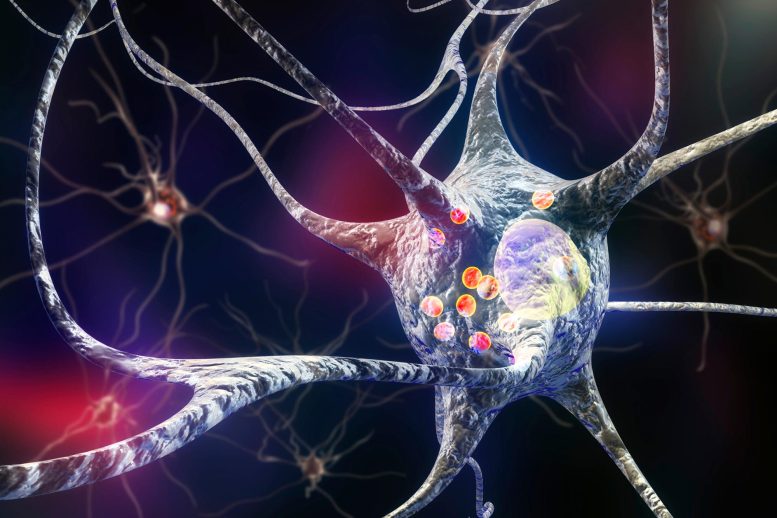
Researchers have made a significant breakthrough in Parkinson’s disease research. Their study reveals that inhibiting a specific enzyme, USP30, in a mouse model can protect dopamine-producing neurons. This finding halts the disease’s progression and opens the door to new therapeutic possibilities for the 10 million people affected by Parkinson’s worldwide.
The findings have the potential to pave the way for new disease-modifying treatments for patients with Parkinson’s disease.
A study published in Nature Communications by Beth Israel Deaconess Medical Center (BIDMC) investigators provides new insights into cellular mechanisms in Parkinson’s disease (PD) progression.
Parkinson’s disease, affecting approximately 10 million people globally, is a neurodegenerative disorder. It is caused by the gradual loss of brain cells that produce dopamine, a neurotransmitter essential for movement and coordination.
As these neurons deteriorate and dopamine levels drop, Parkinson’s patients experience symptoms like tremors, stiffness, and balance and coordination difficulties.
Breakthrough Findings in Parkinson’s Disease Research
Researchers in the lab of senior author David K. Simon, MD, Ph.D., director of the Parkinson’s Disease & Movement Disorders Center at BIDMC, in collaboration with colleagues at the University of Cambridge and Mission Therapeutics, performed complementary experiments showing that inhibiting a specific enzyme in a mouse model protects the dopamine-producing neurons that are normally lost as PD progresses, effectively halting the progression of the disease.
The findings open the door to the development of novel therapeutics targeting the enzyme that may slow or prevent the progression of Parkinson’s disease in people—a major unmet need.
“Our lab is focused on working out the origins of Parkinson’s disease and it is our hope that–one day–we will be able to slow down or even prevent disease progression in patients,” said first author Tracy-Shi Zhang Fang, PhD, an instructor in Simon’s lab. “The current study’s findings pave the way toward that future.”
Study Focus and Methodology
Evidence suggests that dopamine-producing cells die off in Parkinson’s disease because something has gone awry with the clearance of the cells’ old and dysfunctional mitochondria—organelles that are the source of cells’ energy, sometimes called the powerhouse of the cell.
Simon and colleagues focused on an enzyme called USP30 which plays a role in this process. In a mouse model engineered to lack the gene that produces the enzyme — known as a “knockout model” because one specific gene has been deleted for the purposes of experimentation—the researchers observed that the loss of USP30 protected against the development of Parkinson’s-like motor symptoms, increased clearance of damaged mitochondria in neurons, and protected against the loss of dopamine-producing neurons.
In a second set of experiments, the team validated the knockout studies using a proprietary molecule developed by Mission Therapeutics to block the enzyme’s action in the dopamine-producing neurons. As in the knockout mice, inhibiting the enzyme’s action increased the clearance of dysfunctional mitochondria and protected dopamine-producing neurons.
“The two experimental strategies together are much more convincing than either alone,” said Simon, who is also a professor of neurology at Harvard Medical School. “Together, our very significant findings support the idea that reducing USP30 warrants further testing for its potentially disease-modifying effects in PD.”
Reference: “Knockout or inhibition of USP30 protects dopaminergic neurons in a Parkinson’s disease mouse model” by Tracy-Shi Zhang Fang, Yu Sun, Andrew C. Pearce, Simona Eleuteri, Mark Kemp, Christopher A. Luckhurst, Rachel Williams, Ross Mills, Sarah Almond, Laura Burzynski, Nóra M. Márkus, Christopher J. Lelliott, Natasha A. Karp, David J. Adams, Stephen P. Jackson, Jin-Feng Zhao, Ian G. Ganley, Paul W. Thompson, Gabriel Balmus and David K. Simon, 13 November 2023, Nature Communications.
DOI: 10.1038/s41467-023-42876-1
The work was funded by the National Institute of Neurological Disorders and Stroke (grant R21NS109408); the Weston Brain Institute; the Owens Family Foundation; the UK Dementia Research Institute, that receives contributions from UK DRI Ltd, the UK MRC, the Alzheimer’s Society, and Alzheimer’s Research UK as well as a grant from the Romanian Ministry of Research, Innovation and Digitization (no. PNRR-IIIC9-2022-I8-66; contract 760114); a grant from the Medical Research Council, UK (MC_UU_00018/2); Cancer Research UK (Discovery grant DRCPGM \100005); ERC Synergy grant DDREAMM (855741); CRUK program grant C6/A11224, C6/ A18796; Wellcome Investigator Award (206388/Z/17/Z); Cancer Research UK (C6946/ A24843); Wellcome (WT203144). The Sanger Mouse Genetics Project was supported by the Wellcome Trust (098051).









Be the first to comment on "Groundbreaking Discovery: Inhibiting Key Enzyme May Halt Parkinson’s Disease Progression"